

I - Sheet Music for Trumpet
II - Piccolo Trumpets models
III - Maurice André & the Piccolo Trumpet
III
Maurice André and the piccolo trumpet
"The success of my life..."
Maurice André
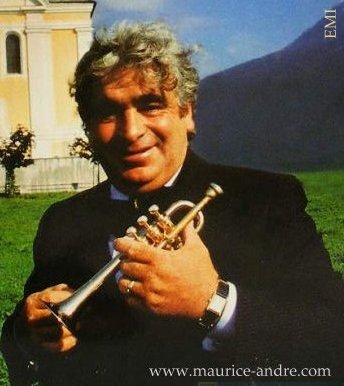
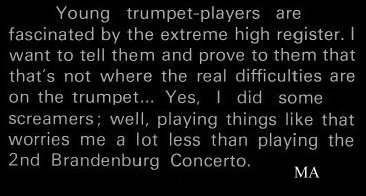
Maurice ANDRE, the father of the piccolo trumpet
By Jan LEONTSKY
Maurice André once spoke about the
piccolo trumpet as "the success of his life"... It is definitely
true.
It would be impossible to speak about master Maurice
André and not to make a special part devoted to the piccolo
trumpet. As a matter of fact,
it was
the Master himself who worked with Selmer to develop a
completely
new trumpet, based on a german model (according to Maurice's own
testimony). After many technical improvements,
Maurice played the piccolo for more than a quarter of a century. It was
in 1959 that Selmer made this strange instrument (originally with 3
valves only) for which nobody knew any repertoire. In the following
years, many technical improvements have been made (the 4th valve was
added in 1967) in close collaboration with Maurice
André.
Maurice was introduced
to Selmer Company by his teacher Raymond Sabarich and started working
on this piccolo trumpet project.
Michel Wykrykacz, Selmer's prototypes department director
remembers :
" Maurice André
has
been greatly involved
in all the process of making this new trumpet. He wanted to improve the
quality of its sound and also the ergonomic of the instrument. Maurice André very much liked to work at home
on technical improvements and
to try out new things. Together, we worked a lot on leadpipes. When he
used
to come in the morning, he would play a few notes and we were all
impressed... All was perfect at once."
If Adolf Scherbaum had been an idol for the young Maurice, it is our great french trumpet player that developed the piccolo trumpet repertoire. He played this instrument much more than the standard trumpets. Maurice André has been, above all, the master of the piccolo trumpet. After the Munich's competition (1963) Maurice André recorded many albums with the greatest german conductors : Böhm, Münchinger, Karajan and mainly the Münchener Bach-Choir conducted by the great Karl Richter. It is this new "invention" - the piccolo trumpet - that Maurice played on all these baroque repertoire. If we consider all Maurice's recordings, it is clear that the piccolo takes the first place. He's the real father of the piccolo trumpet. Let's now have a closer, more historical look on the trumpet repertoire.
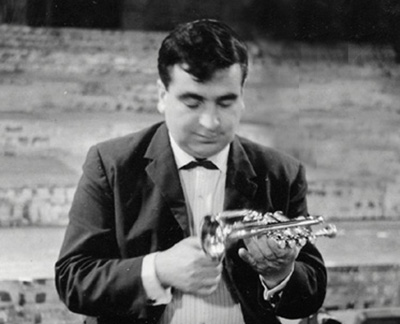
Rehearsal Karl Richter - 1964
"When I began my career, people hardly knew Telemann or Vivaldi..." Maurice André
Except for some
concerti, a few baroque works and the orchestral parts of Bach, there
were few serious
music pieces to be played for the young Maurice André
when he was studying the big trumpet with Sabarich at the Paris'
Conservatory. The trumpet
repertoire was small at this time. The classical
period left us the Haydn and Hummel concerti, real masterpieces.
Mozart,
Beethoven, Schubert or Schumann did not write any trumpet concerti, or
sonatas
for the solo trumpet. The Nineteenth century gave us
orchestral parts for
the trumpet but no real solo repertoire. Therefore, we can say that,
before Adolf
Scherbaum,
the solo trumpet repertoire was very small.
The great contribution of Scherbaum was to re-discover the baroque
repertoire
through a real new instrument : his little Bb piccolo trumpet. With his
trumpet,
he has been able to play forgotten baroque pieces (written in the
clarino register -
high register) that nobody could play at this time with the big trumpet.
*
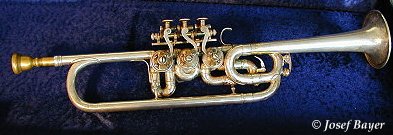

Scherbaum
was famous for his interpretation of the 2nd Brandenburg concerto (he
performed it over 400 times and recorded it 14 times). He recorded also
many new baroque
pieces, as shown in this list.
But Adolf Scherbaum was born in 1909. When Maurice won the decisive
Munich competition, Scherbaum was 54 years old. There were 24 years
between Maurice André and Adolf
Scherbaum....One generation.
It is therefore Maurice André that endorsed this
completely new repertoire and followed Scherbaum to develop piccolo
trumpet playing into perfection.
*
A secret of the Master : searching for the quality of the attacks while working on intervals...
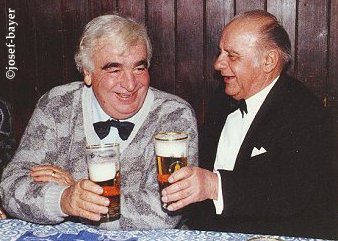
Maurice André with his precursor, Adolf Scherbaum
It was Maurice André that made piccolo trumpet music into a completely new and unique repertoire. He has been an incredible pioneer with his new and unique instrument in his hands. He developed this repertoire from transcriptions and forgotten baroque works, for many works were known but nobody could technically play them. With the piccolo trumpet, everything was possible. The great arranger Jean Thilde (Billaudot), who worked for years on all these gorgeous transcriptions, must also be mentioned.
*

(MODELE 360 B)
It is through
the will
of Maurice André that the piccolo trumpet entered
into the musical world. By his
energy, his curiosity, he has raised this little, unknown instrument to
the
rank of the most well-known. If Scherbaum has shown the way,
it is Maurice André
who has accomplished
this idea of giving a new repertoire to a new
instrument. Even today, nobody plays the piccolo trumpet as
Maurice
did.
Such perfection seems to be unique in all music history...until
now.
*
I will add that, if Maurice André played the piccolo trumpet so long - and almost only this instrument - all along his career, this is due to technical reasons. The piccolo trumpet is not a big trumpet that would play high notes. It is a definitely unique instrument. The soloist, the real professional players, cannot go from the piccolo to the big trumpet, and vice-versa - all the time without great difficulties or even danger. Playing the piccolo requires a most special pressure, phrasing and tonguing. Piccolo trumpet is a great demanding instrument. The professional player - Scherbaum is also the proof of that - can only specialize in this peculiar instrument to reach the flawlessness, the perfect musical results and, above all, the musicality, without which there is no Music but only notes...
*
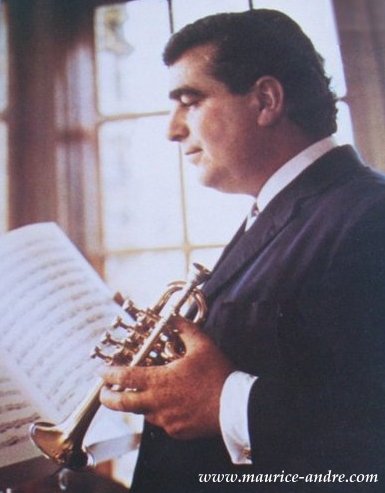
(MODEL 360 BL)*
*
|
"Of course, the piccolo trumpet helped me greatly, but you also need iron-lips"
|
MP3 - Samples T.Albinoni. Sonate Remin/Dmin - Allegro G-F Handel. Sonate en La/in A - Andante G-F Handel. Sonate en Fa/in F - Allegro T.Albinoni. Concerto en Fa/in F - Allegro
|
*
Scherbaum vs. André...
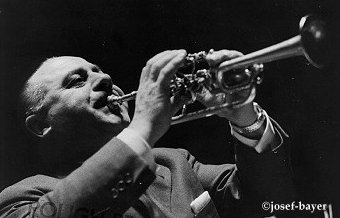
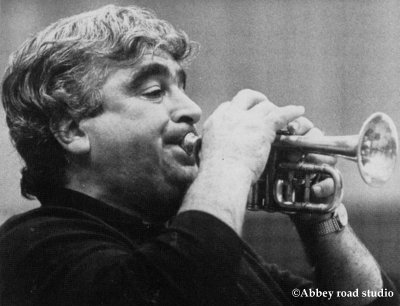
The
amazing high register of Adolf Scherbaum brought him to
specialize in
the baroque repertoire (clarino register) through a new little
trumpet. Adolf Scherbaum was, for this period,
a phenomenon of the high notes. i For example, in
the perilous concerto of Michael Haydn, he climbs until the
high- A. Nevertheless, Scherbaum has not the fineness, the
musical elegance of Maurice André. Mainly, he
hasn’t
Maurice’s incredibly “round”
sound. Was the
sound of Scherbaum linked to his instrument ? Yes,
no
doubt. It is undeniable that the Scherzer piccolo trumpet of
Scherbaum was a rudimentary instrument (compared to the 1967
Selmer). This instrument was capricious (as intonation is
concerned)
and it rendered also poor harmonics in low notes.
Even
Scherbaum’s mouthpiece (a very shallow cup) contributed to
this poorness
in the low notes.
Even if, in the Brandenburg, Scherbaum excelled by his flawlessness and
his admirable tonguing, Maurice André surpassed
him by
the splendid musicality
he put in this most difficult concerto (as well as in all his
interpretations). If Maurice said : "Scherbaum was
my only predecessor and one of
my idols", it remains that our French trumpet player quickly imposed
his amazing piccolo trumpet playing, by far superior to Scherbaum's
technique and musicality.
*
Listen to the Badinerie from the B minor orchestral suite. Arranger : JM Defaye. Maurice André - Piccolo in A.
"Many young players have technique and sound but sometimes they lack musicality"
............................................................................................................................................................Maurice André
*
Listen
on Youtube Maurice André
playing the Aria - Mein gläubiges Herze - from cantata Bwv
68.
Selmer piccolo trumpet in Bb. Admirable
tonguing in the
high notes (high-F), perfection of sound and technique...
The flawless
art of a genius of the interpretation, as Jascha Heifetz or Sviatoslav
Richter.
*
From the beginning, the piccolo trumpet has been linked to baroque repertoire, since this was re-discovered by this instrument. Yet, after Maurice André's huge impact, piccolo's repertoire is not developing anymore. No sonatas, no concerti. Only some parts are played by the piccolo, as it was the case in the baroque orchestral works. The most famous "passage" written for piccolo trumpet is Penny Lane*. After that comes the "Badinerie" from BWV 1067 orchestral suite, transcribed from the flute, and played by Maurice in a miraculous way, with all the musicality of a true genius of interpretation.
Piccolo trumpet is not like a high playing big trumpet. It is a complete new instrument. I do hope that young piccolo trumpet players will ask contemporary composers to write music for this magic instrument. I do hope young players will have the same faith that Maurice André had in his career. This way piccolo trumpet will keep on living.
* Technical note on Penny Lane : Played by David Mason (see video on Youtube) the piccolo trumpet part of Penny Lane was written by Paul Mc-Cartney after having heard and seen the 2nd Brandenburg concerto played on BBC TV. The part is written in B major and played on the A piccolo trumpet (D major). It is interesting to note that David Mason, in the first part of the video, plays the final of the Brandenburg tuned in Bb and after that, changed the tuning to put his piccolo in A and play Penny Lane.
For Maurice, it was the beauty of the sound that was the heart of the trumpet. The beauty of the sound and the musicality.
*
(SCHERZER ROTARY MODEL)
See main piccolo trumpet mouthpieces
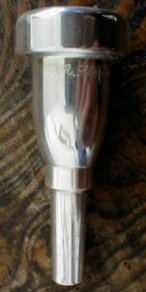
Piccolo mouthpiece created by my friend Rudi Stuber (UCSB)
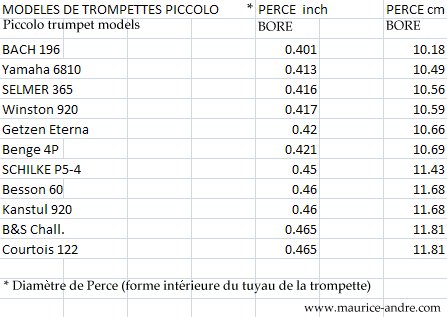
Maurice Andre's piccolo
mouthpieces
Bach 7 DW
Bach 7 DW
For the high
pieces(Brandenburg No. 2) Selmer 1 mouthpiece
(Source : Louis Davidson)
(As the big trumpet is concerned, Maurice played a very long time Bach 1 1/2 C but with specific flattened rims.Maurice
like flat rims. He also work with Selmer on a special mouthpiece with a slightly wider upper rim. He said that changing one's mouthpiece
was very dangerous, anyway.)
Yet, mastery and musicality do not lay in a piece of copper like a trumpet, a leadpipe or a mouthpiece.
"For the most part, you must practice (big & piccolo tpt) in the
dynamics p or mf to construct your playing
with calm and to control effectively
what you're doing." M.A
***
Maurice has never
occupied himself a lot with equipment questions :
trumpets, mouthpieces, leadpipes, etc...
The physical parameters in trumpet playing were not essential
to
him. Only daily work, performances and recordings made his
career.
He used to think that other trumpet players did not work as much as he did. and therefore did not get the same results.
The technique training of Maurice was : to work on all kinds of articulations, for hours. He always chose
training exercises accordingly to his various concert programmes : an hard concert = a soft training, and vice-versa.
He did not play all the time the same execises.
As warming up is concerned, he used to play slurs, chromatic scales, everything that won't damage
the lips. He used to massage his upper lip (not the lower) every evening with the "indian skin cream".
"This massage is a tremendous help", he said.
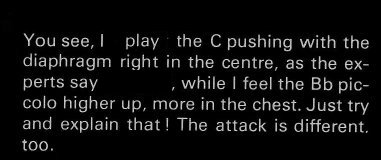 MA
MA
*
Listen via Youtube to
Maurice playing a boldy arrangement (in F major) of the Concerto in E
major for harpsichord,
strings and continuo, BWV 1053.
Eight minutes of an amazing performance played on the Bb piccolo tpt.
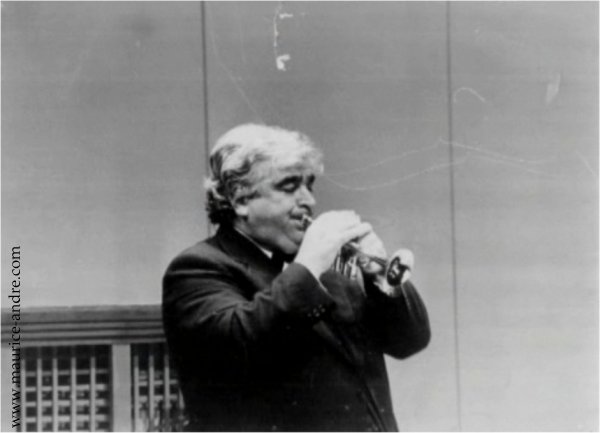
"Try to work always mezza voce, as Arban taught." M.A
Maurice Andre's daily warm-up
(Thanks to my friend Ole J. Utnes for this quotation)
1) I waken up the muscles and the lips with buzzing exercises and with the mouthpiece alone,
taking care to use no pressure on the lips (I don't worry about the sound at all!)
2)I move on to the instrument with scale and arpeggio exercises, still very lightly,
without pressing and still without worrying about the sound.
3) I start chord arpeggios over again, but this time looking for good sound.
I insist on flexibility, working as slowly as possible. Next I go on to wider
and wider intervals (fourths, fifths, single, double and triple octaves),
still very slow and pressing as little as possible.
4)I do no. 3) again staccato.
When that's done, I can go on (for however long it takes) to my concert programme.
I also practise changing instruments and mouthpieces.
Every night, before going to bed, I conscientiously massage my lip muscles with butter,
which is rich in vitamin E.
For me the main things in trumpet playing are looking for
the right sound and a precise attack.
(Srce. Brass Bulletin.)
*

"Piccolo Trumpet Lamp"
*
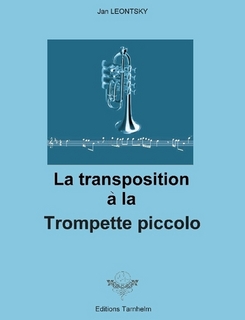
*
A very rare and interesting Bb piccolo by Couesnon, early XXth century : The Monopole Conservatoire (n°23897)
Technical innovation used to be a great tradition in France. But Japan & China - with their "low-price" policy - killed all our craftsmanship.
Simply because people wanted to pay less money... Now, they get what they pay for :) No more.
See the main intake Branch, directly connected to the 3d valve case.
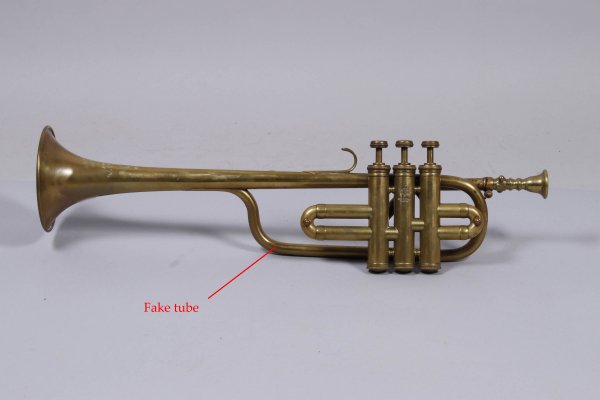
The uncommon fake tube.
*
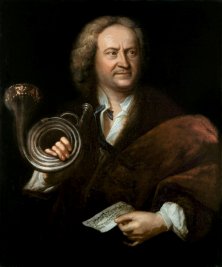
Gottfried Reiche, and his Tromba da caccia
Piccolo trumpet and Natural trumpet
As we all know, the repertoire of the Natural
trumpet, a baroque trumpet without holes ("évents", in french),
with its high register, called "clarino", is the direct ancestor of the
Piccolo trumpet. The great pioneer of
the Natural trumpet repertoire was Gottfried Reiche (1667-1734), for
whom BACH wrote, in his cantatas of Leipzig, most of these first trumpet flamboyant parts. Reiche
died, moreover, the day following a concert, victim of "an attack,
which occurred after he had played the cantata BWV 215, on October 5,
1734" *.
Technically speaking, and to make things clear, the natural trumpet is exactly like a cavalry trumpet or even a hunting horn. It’s an instrument that uses the natural harmonics of a fundamental sound. The more you go to the high register (following the natural succession of harmonics) the more notes you can play. So, in the high register, you can play real melodies: this is the specific register of this instrument, called "clarino"..
It is the english baroque vogue (in fact, initiated by Antoine Geoffroy-Dechaume) which has brought up to date this forgotten instrument. It's been the same for the viola (viola da gamba), an instrument which was once much more famous than the violin (used as an instrument to make people dance). Total reversal of situation which changes a plebeian instrument into an aristocratic one. More generally, regarding these "baroque" instruments, this return to instruments which, in terms of instrumental craftsmanship, are very archaic compared to ours, seems quite ironic. But it is a fashion of our times and, de gustibus non est disputandum ... it is useless to discuss about tastes !
Maurice André knew about the
Natural trumpet but it seems he's been to much involved in the piccolo
trumpet playing. Therefore, it is hard to say if he would have been
interested in
this instrument or not (as Alison Balsom does today - the gravy train).
Anyway, we have, in France, the master of the natural trumpet : Jean-François Madeuf.
He is the great representative of the baroque trumpet, the real one!
Because, as I already wrote, the natural trumpet has no holes (these
holes which allow the air column's length to vary, changing the
notes). There are other well-known baroque trumpet players, such as
Edward Tarr (who died in March 2020) or Friedemann Immer ... But they
use the holes to get some notes an easier way ... Jean-François
Madeuf, does not. And here is the great "tour de force" of our time:
"Low hats, gentlemen!" as Schumann said, speaking about Chopin.
By listening to the master Jean-François Madeuf, we are in direct contact with Gottfried Reiche ... No more, no less.